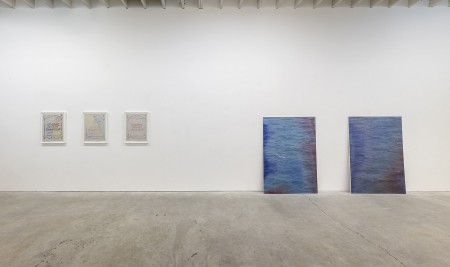18 January to 24 February 2024

Optical Fingerprint
Lenticular images are peculiarly unstable. At a large scale, the density of the lens material is impossible to keep consistent. So, although lenticular printings create copies, each lens and its varying densities are unique. The lens itself produces an "optical fingerprint." Gareth Long could correct these inconsistencies, but the decision not to correct them is intentional. He is interested in the liquidity of the medium. The idea of liquidity is present in the work as both subject matter and part of how the artwork is structured and produced. The lenticular prints are generated waterscapes with 3D software and modelled using ocean and river geometry and a combination of complex mathematical models and direct observations. The scenes are lit using environment lighting from actual photographs Long took of bodies of water recently visited; these prints amalgamate the coast of Fogo Island and the Delaware River in upstate New York. These rendered animations are then set into motion using the particular properties of lenticular technology, with its undulating waves of colour bands. There are generated waves and optical waves created by the lenses, which are flowing at their own rates. One is flowing based on the water in Long's renderings, and one is flowing based on the movements of the viewers' eyes. The wave effect of the image is activated by a viewer's movements and is inherently relational, meaning that no two viewers will ever see the same image.
Delaware Abstract Corporation
The name of a company that determines legal ownership of properties in Delaware County. Also, the words sprawled onto the company's sign, which Long came across while spending time along the Delaware River in upstate New York. These "rubbings" were produced by coming into direct contact with the sign's surface. As portraits of place, they are complex. They are indexically linked to their place of origin. However, they also evoke the spectre of non-place. The State of Delaware is best known for being a tax haven where countless companies incorporate even though they have no connection to the state itself. Although not located in the State of Delaware, these "rubbings" are physically linked to a "real" place, then, but at one remove, evoking the shadowy no man's land of a place where corporations are "sited," without actually being physically on site. From this single source imagery, Long produces another series of "copies" in which the results are more abstract than summary. They are ghostly impressions, and put into question familiar parameters of representation. What is real and what is not, what we know to be an index of place and what has become forever muddied, blurred, unlocatable, shifting like the movement of his hand.

